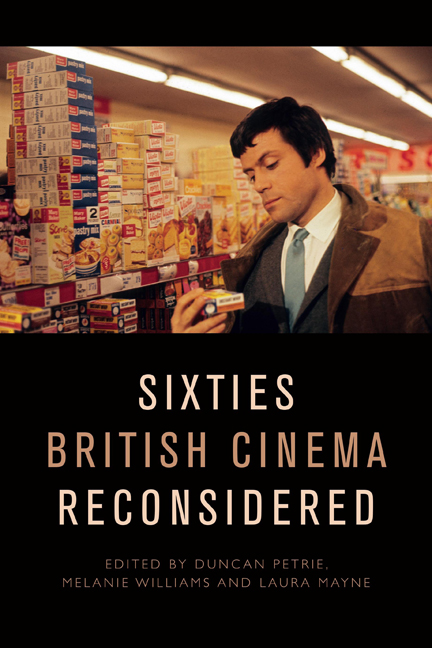Book contents
- Frontmatter
- Contents
- List of Figures and Tables
- Notes on the Contributors
- Introduction
- PART ONE STARS AND STARDOM
- 1 Male Stardom in 1960s British Cinema
- 2 ‘Rebel Rebel’?: Oliver Reed in the 1960s
- 3 Carol White: The Bardot of Battersea
- 4 ‘The Old Wave at Work’: The Transatlantic Stardom of the British Character Actress in the 1960s
- PART TWO CREATIVE COLLABORATIONS
- 5 Woodery-pokery: Charles Wood’s Sixties Screenwriting
- 6 ‘Beyond Naturalism’: Jocelyn Herbert, If . . . (1968) and Design for Performance in 1960s British Cinema
- 7 Kes: From Page to Screen
- 8 ‘I’d like to remember you as you are – as just a grumpy old man’: Joseph Losey and the Making of Figures in a Landscape (1970)
- PART THREE STYLE AND GENRE
- 9 ‘Wholesome rough stuff’: Hammer Films and the ‘A’ and ‘U’ Certificate, 1959–65
- 10 Widescreen Pyrotechnics: Shot Composition and Staging in the Cold War Films of Joseph Losey and Sidney J. Furie
- 11 The Rise and Fall of the Colourful Corporate Fantasy in 1960s British Cinema
- 12 Witchfinders and Sorcerers: Sorcery and Counterculture in the Work of Michael Reeves
- PART FOUR CULTURAL TRANSFORMATIONS
- 13 ‘An Impulse of Anger, Instantly Regretted’: Rebellion and Reaction in the Early-1960s Naval Film
- 14 Narratives of Race and Identity in Sixties British Cinema
- 15 Panic at the Disco: Brainwashing, Alienation and the Discotheque in Swinging London Films
- Index
4 - ‘The Old Wave at Work’: The Transatlantic Stardom of the British Character Actress in the 1960s
Published online by Cambridge University Press: 22 September 2020
- Frontmatter
- Contents
- List of Figures and Tables
- Notes on the Contributors
- Introduction
- PART ONE STARS AND STARDOM
- 1 Male Stardom in 1960s British Cinema
- 2 ‘Rebel Rebel’?: Oliver Reed in the 1960s
- 3 Carol White: The Bardot of Battersea
- 4 ‘The Old Wave at Work’: The Transatlantic Stardom of the British Character Actress in the 1960s
- PART TWO CREATIVE COLLABORATIONS
- 5 Woodery-pokery: Charles Wood’s Sixties Screenwriting
- 6 ‘Beyond Naturalism’: Jocelyn Herbert, If . . . (1968) and Design for Performance in 1960s British Cinema
- 7 Kes: From Page to Screen
- 8 ‘I’d like to remember you as you are – as just a grumpy old man’: Joseph Losey and the Making of Figures in a Landscape (1970)
- PART THREE STYLE AND GENRE
- 9 ‘Wholesome rough stuff’: Hammer Films and the ‘A’ and ‘U’ Certificate, 1959–65
- 10 Widescreen Pyrotechnics: Shot Composition and Staging in the Cold War Films of Joseph Losey and Sidney J. Furie
- 11 The Rise and Fall of the Colourful Corporate Fantasy in 1960s British Cinema
- 12 Witchfinders and Sorcerers: Sorcery and Counterculture in the Work of Michael Reeves
- PART FOUR CULTURAL TRANSFORMATIONS
- 13 ‘An Impulse of Anger, Instantly Regretted’: Rebellion and Reaction in the Early-1960s Naval Film
- 14 Narratives of Race and Identity in Sixties British Cinema
- 15 Panic at the Disco: Brainwashing, Alienation and the Discotheque in Swinging London Films
- Index
Summary
While much has been written about the part played by British stars in the resurgent national cinema of the 1960s, the contribution of character actresses has largely been overlooked. Despite lacking the glamour and pin-up potential of younger stars, actresses such as Edith Evans, Wendy Hiller and Margaret Rutherford were to play a key role in the emergence of a British cinema which appealed to an international audience, at a moment when each appeared to be in the twilight of their film careers. These individuals were cast in roles constructed around iterations of Britishness, specifically Englishness, which played well with American studios and audiences, as well as offering familiarity and continuity for British audiences. Their roles evoked discourses concerning nostalgia, class and national identity, often in counterpoint to the pervasive spirit of rebellion, youth, and sexual liberation more commonly associated with the 1960s.
Melanie Williams likens British character actors to ‘brilliant miniaturists’, whose work may be exiled to the periphery of the narrative but is ‘as vital to the alchemy of the film as its major performances’. As Raymond Durgnat observed at the end of the 1960s, post-war British cinema offered a production context wherein ‘roles abound’ for the character actress, who offered a ‘complete contrast to the equal and opposite Hollywood imbalance, all optimism, glamour and little character’. Nevertheless, despite the opportunities and success enjoyed by the British character actress in the first half of the decade, the mid-1960s marked the beginning of the end of a golden age for female character players.
Evans, Rutherford and Hiller typified this late life career flourish; their talents as supporting actresses were sought after to boost the prestige of film projects and were often key to greenlighting the production and the subsequent promotion of the film. Their value was recognised by the ‘old wave’ and new directors alike, with Hollywood stalwarts also keen to add the experience and status of these grandes dames to their productions. American Studios were keen to embrace their appeal to the American urban arthouse audience. They offered substance and reliability in contrast to the rather less predictable talents of Hollywood A-listers and less seasoned younger stars, on account of their experience and status in the theatrical world.
- Type
- Chapter
- Information
- Sixties British Cinema Reconsidered , pp. 63 - 78Publisher: Edinburgh University PressPrint publication year: 2020

